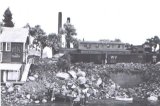 This old photo shows Winter Valley employees making up a train just west of Pearson only twelve hours of the formation of the prairie short line. In the early years all of
This old photo shows Winter Valley employees making up a train just west of Pearson only twelve hours of the formation of the prairie short line. In the early years all of
the engines were leased from the CNR and they weren’t always in the best condition. Long hours in the shop were all that it took to keep the line running.
The original N Scale layout moved from place to place a great deal. Air Force lifse took it’s toll on scenery but I soon learned to speed things up by using natural materials where ever I could get away with it. This photo shows a riprap embankment made of real stones. The colour can’t be wrong. I still do this wherever possible – even in Large-Scale scenes.
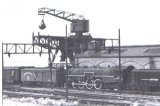 As the CNR retired it’s newer, larger steam power they often became available for work on the Winter Valley. This picture shows that even a heavy, modern engine can be pressed into work as a switcher when the need arises. Here is a big Hudson locomotive earning its keep at the Fox Creek coal loader.
As the CNR retired it’s newer, larger steam power they often became available for work on the Winter Valley. This picture shows that even a heavy, modern engine can be pressed into work as a switcher when the need arises. Here is a big Hudson locomotive earning its keep at the Fox Creek coal loader.
Hay, if you like it – run it. Even in the N Scale days, when there was a large selection on engines on the shelf, I went wild from time to time and bought items that didn’t quite fit. This engine was actually a favourate of mine. Visitors to the layout often like the steam engines better than the modern diesels so…..
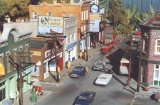 Busy downtown Pearson in the summer of ’78. The continued operation of the local railroad has brought prosperity to this community as well as others on the 115-mile line. Track improvements have meant that new high horsepower diesels can move an unlimited supply of goods, in all weather. This helps support a small local manufacturing sector and that in turn keeps young people from going off to the “big city”.
Busy downtown Pearson in the summer of ’78. The continued operation of the local railroad has brought prosperity to this community as well as others on the 115-mile line. Track improvements have meant that new high horsepower diesels can move an unlimited supply of goods, in all weather. This helps support a small local manufacturing sector and that in turn keeps young people from going off to the “big city”.
I never intended for the Winter Valley to be more than a small branch line service. This fit well into our family situation. If I had to move often – I didn’t want much to move. But I enjoyed kit-bashing buildings that were near copies of existing small town structures and so the collection seemed to grow over the years. Soon I had a small city on the layout, and then there were two. I can’t see this happening in 1/24th scale but you never know.
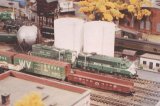 As the Winter Valley grew and prospered the small engine facility that was left behind in Pearson by the CN grew to become the main maintenance complex on the railroad. A modern diesel shop soon replaced the roundhouse and the fuel storage site doubles as a farm fuel distribution business.
As the Winter Valley grew and prospered the small engine facility that was left behind in Pearson by the CN grew to become the main maintenance complex on the railroad. A modern diesel shop soon replaced the roundhouse and the fuel storage site doubles as a farm fuel distribution business.
This yard was located “behind” the main streets of the town. Much as in real life, the trains can only be seen as they come and go between buildings. This scenery trick added realism to the layout and I have tried to continue that practice in the garden and on the new Large-Scale layout in the basement.
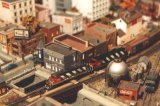 The Winter Valley exchanges traffic with the CN at Grande Prairie and, at the south end, at Grizzly Junction. This is an overhead shot of a CN train moving through Edmonton with tonnage for the WVRR. An operating arrangement allows CN extra movements over WV trackage as necessary. This insures that the WVRR can keep to its schedule every day and customers can still get unscheduled service on occasion.
The Winter Valley exchanges traffic with the CN at Grande Prairie and, at the south end, at Grizzly Junction. This is an overhead shot of a CN train moving through Edmonton with tonnage for the WVRR. An operating arrangement allows CN extra movements over WV trackage as necessary. This insures that the WVRR can keep to its schedule every day and customers can still get unscheduled service on occasion.
Everyone loves to run a lot of engines and everyone has their favourate railroad. I love running CN engines and rolling stock. In fact, it makes up a very large portion of my model railroad “stuff”. But having my own railway gives me the freedom to run a few things that were never seen on CN rails.
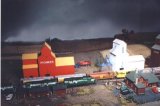 The Winter Valley stayed true to its roots. Even in today’s economy they can still be seen switching the wooden grain elevators along the right-of-way between Grizzly Junction and Grande Prairie. The namesake town of Winter Valley never grew to be the largest settlement in the valley but remains an important agricultural stop along the way.You can’t have to many grain elevators.
The Winter Valley stayed true to its roots. Even in today’s economy they can still be seen switching the wooden grain elevators along the right-of-way between Grizzly Junction and Grande Prairie. The namesake town of Winter Valley never grew to be the largest settlement in the valley but remains an important agricultural stop along the way.You can’t have to many grain elevators.
Well, not if you’re modelling the Canadian West. In N Scale there was always room for two or three in every town. In G Scale I may just have to be content with one. So far. They averaged about 70 feet in height so obviously some restrictions apply. These prairie skyscrapers make great focal points for the layout.
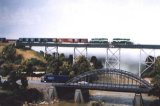 Today the Winter Valley operates in the black. The little railway that could is at the very centre of economic activity in the valley. Modern, high horsepower, SD40-2’s move coal, oil products, farm and mining machinery, light manufactured goods, as well as grain, to markets as far away as Japan. These Winter Valley engines are seen making their way out over the Wapiti River Trestle just south of Grande Prairie. Highway 40 is in the foreground.
Today the Winter Valley operates in the black. The little railway that could is at the very centre of economic activity in the valley. Modern, high horsepower, SD40-2’s move coal, oil products, farm and mining machinery, light manufactured goods, as well as grain, to markets as far away as Japan. These Winter Valley engines are seen making their way out over the Wapiti River Trestle just south of Grande Prairie. Highway 40 is in the foreground.
Don’t forget the roads and highways. Sure, they’re the competition but they’re all over the landscape, Out in the garden I use the “roads” as walking paths that get me to and from railroad sites and down in the basement parts of the highway are used for “work stations” without messing up the scenery.